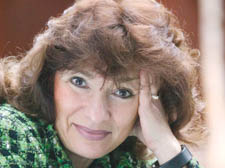|
|
 |
| |

Lisa Appignanesi |
Are women crazy or does the world mould them into madness?
Females have borne the brunt of mental illness, historian Lisa Appignanesi tells Peter Gruner
SCIENTISTS in the 19th century thought women had smaller brains than men and that giving them education would dissipate their energies and make them ill.
With all the pressure on women to conform to a neat Victorian stay-at-home stereotype it was not surprising that many did become mentally unstable, writes Lisa Appignanesi in her fascinating new book, Mad, Bad and Sad: A History of Women and the Mind Doctors from 1800 to the Present.
Each generation has thrown up a different expression of mental illness, she reveals.
In Georgian England melancholy was a “fashionable” condition for those of sensibility.
By the late 19th century hysteria was all the rage and doctors were advocating as a cure hearty exercise and in the case of ardent young women – marriage.
Today – a time of relative plenty, at least in the western world – eating disorders like anorexia and bulimia are on the rise as women desperately try to maintain a thin, fashion-model image.
Ms Appignanesi, who lives at Archway and will be speaking at two big literary events this week – Jewish Book Week and Connecting Conversations – focuses on women because they were more likely to have become victims of mental illness.
Perhaps today that is changing as men, no longer the sole bread winners, struggle to find their own role in society.
Her case studies range from the depression suffered by Virginia Woolf and Sylvia Plath to the mental anguish and addictions of iconic beauties Zelda Fitzgerald and Marilyn Monroe.
She analyses the work of Freud and Jung and more recent psychological thinkers like RD Laing, who in the 1960s said that mental illness was the right response to a mad society. The 1960s also marked the end of the era of locked mental asylums and the start of what is now termed care in the community.
Mental illness is on the increase. One in five women develops clinical depression and in a recent 14-country survey on disability, psychosis was ranked the third most disabling condition. Between 1992 and 2002 the use of antidepressants went up by 234 per cent. Three-quarters of the female prison population in Britain suffer from mental health problems.
In the 1860s nerves became the focus of mental and emotional problems. Ms Appignanesi writes that in Wilkie Collins’s novel The Woman in White (1860), the character Mr Fairlie was given characteristics described as feminine: “He was an ‘effeminate’, ‘womanish’ invalid who suffered from a disorder of the nerves. This included an attendant aesthetic over refinement and weakened judgment.”
Victorians managed to turn the nervous system into an economic model as they did with sexuality. “Each person had only a certain amount of nervous energy,” Ms Appignanesi writes, “an inherited capital fund that could be easily depleted.” She says the Victorians believed sexual activity without an aim to have children was bad and incapacitating – as was masturbation.
It was thought that overburdening the nervous system would weaken the reproductive system. There was even a fashion for pelvic surgery, with disastrous effects on women’s health, as a cure for ailments as disparate as fatigue and vomiting.
By the 1870s, women started demanding not only the vote and equality within marriage, but education and greater freedom of activity. But they were met with the newly mobilised strength of the scientific and medical establishment. “The medical warnings against any activity that might change women’s domestic status, as seen as a fact of God and nature, were deafening,” Ms Appignanesi says.
Leading academics proposed that women had smaller brains and were intellectually inferior to men as well as being childlike in nature. “Girls were over-emotional, had a deep sense of dependence, craved sympathy and were able mimics. They had sensitive and highly strung nerve centres apt to be damaged by pressure, whereas boys were more ‘obdurate and resistant’,” Ms Appignanesi adds.
Thank goodness for Elizabeth Garrett Anderson (1836-1917) who struggled against great odds to become the first woman doctor in Britain and the founder in 1871 of the New Hospital for Women. She married, had three children, and was living proof of why the mad male medics were so wrong.
Says Ms Appignanesi: “Throughout history women have been forced into various roles, and anybody, male or female, tends to crack when they can’t conform to what is expected of them. Symptoms and diagnosis fall into the culture of the time.”
Without coming down on the side of any so-called cure or therapy, Ms Appignanesi supports talking therapies as the most humane. “I would like to see more talking therapies on the National Health,” she said, “because they would help a lot of people.”
|
 |
|
 |
 |
|
 |
|


